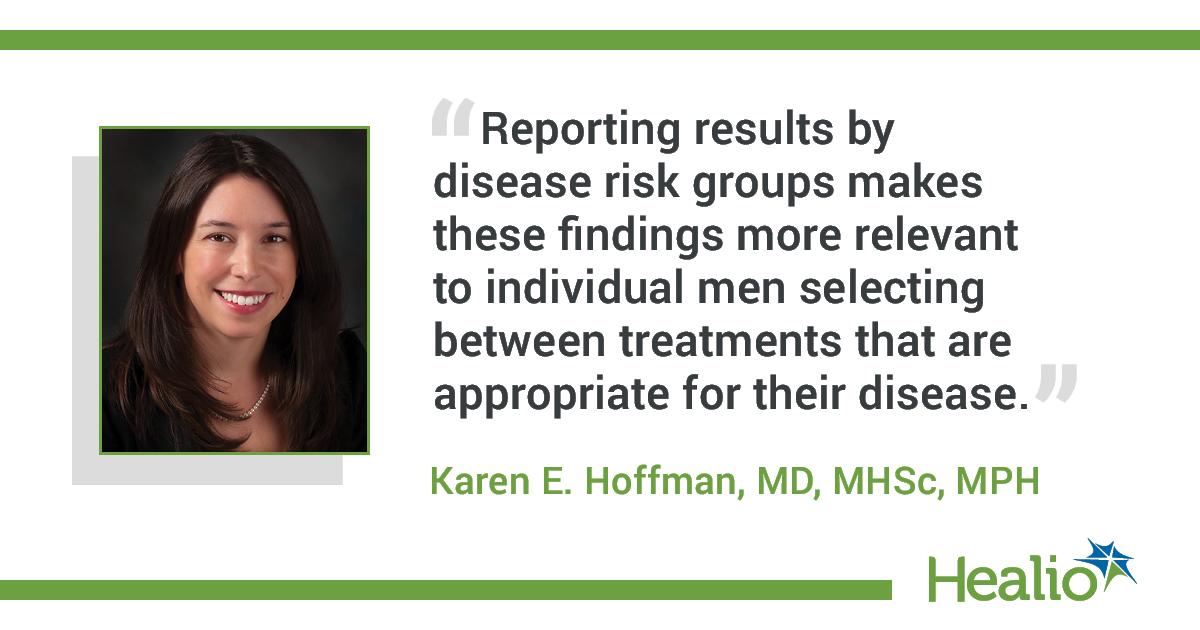Patient-reported outcomes could help guide selection of treatment for localized prostate cancer

Patient-reported adverse effect profiles 5 years after contemporary treatment for localized prostate cancer could help inform treatment choices for this patient population, according to study results published in JAMA.
“Surgical and radiotherapy treatment techniques for localized prostate cancer have changed over the past few decades, and these changes have been adopted in part because they are believed to reduce treatment side effects. Additionally, there is increasing use of active surveillance,” Karen E. Hoffman, MD, MHSc, MPH, oncologist in the department of radiation oncology at The University of Texas MD Anderson Cancer Center, told Healio.
“We wanted to better inform men selecting among the multiple treatment options for localized prostate cancer,” she added. “We therefore prospectively evaluated the adverse effects men experience 5 years after contemporary treatment and reported the comparative harms of prostate cancer treatments from the patient perspective.”
The prospective study included 2,005 men (median age, 64 years; interquartile range, 59-70; 77% white) with prostate cancer diagnosed between 2011 and 2012 and included in five SEER program registries and one U.S. prostate cancer registry.

Men considered favorable risk had stage cT1 or cT2bN0M0 prostate cancer, PSA levels of 20 ng/mL or lower, and grade group 1 or 2 disease. Those with unfavorable-risk prostate cancer had stage cT2cN0M0 disease, PSA of 20 ng/mL to 50 ng/mL, or grade group 3, 4 or 5 classification.
Of the 1,386 men with favorable-risk disease, 363 (26%) opted for active surveillance, 675 (49%) underwent nerve-sparing prostatectomy, 261 (19%) had external beam radiation therapy (EBRT) and 87 (6%) received low-dose-rate brachytherapy.
At 5 years, 25% of men managed by active surveillance progressed to definitive therapy. Of these, 44 (48%) underwent EBRT, 37 (43%) underwent prostatectomy, five (6%) underwent androgen deprivation therapy and three (3%) underwent ablation.
Of the 619 men with unfavorable-risk disease, 402 were treated with prostatectomy and 217 with EBRT plus ADT.
Researchers used the validated 26-item Expanded Prostate Index Composite (EPIC) score to evaluate patient-reported disease-specific function. They evaluated general health-related quality-of-life domains, such as physical functioning, emotional well-being and energy and fatigue, with the validated Medical Outcomes Study 36-Item Short Form Survey. Researchers conducted surveys through September 2017 with response rates of 97% at 6 months, 94% at 1 year, 85% at 3 years and 77% at 5 years.
Researchers observed no statistically significant differences in prostate cancer survival during the study’s 5-year follow-up period. One prostate cancer-related death occurred in the favorable-risk group vs. eight deaths in the unfavorable-risk group.
Men with favorable-risk disease treated with nerve-sparing prostatectomy self-reported worse urinary incontinence at 5 years (adjusted mean difference, –10.9; 95% CI, –14.2 to –7.6) and worse sexual function at 3 years (adjusted mean difference, –15.2; 95% CI, –18.8 to –11.5) than men managed with active surveillance.
Compared with men managed with active surveillance, those treated with low-dose-rate brachytherapy self-reported worse urinary irritative symptoms (adjusted mean difference, –7; 95% CI, –10.1 to –3.9), sexual function (adjusted mean difference, –10.1; 95% CI, –14.6 to –5.7) and bowel function (adjusted mean difference, –5; 95% CI, –7.6 to –2.4) at 1-year follow-up.
Changes in urinary, sexual and bowel function through 5 years of follow-up did not differ clinically between men managed with active surveillance and men treated with EBRT, according to the researchers.
Men with unfavorable-risk disease treated with EBRT plus ADT self-reported decreased hormonal function at 6 months (adjusted mean difference, –5.3; 95% CI, –8.2 to –2.4) and bowel function at 1 year (adjusted mean difference, –4.1; 95% CI, –6.3 to –1.9) compared with men who underwent prostatectomy.
Conversely, these men self-reported better sexual function at 5 years (adjusted mean difference, 12.5; 95% CI, 6.2-18.7) and incontinence at each time point through 5 years (adjusted mean difference, 23.2; 95% CI, 17.7-28.7) then men who underwent prostatectomy.
Baseline health-related QOL domain scores were highest among men who underwent prostatectomy and lowest for men who underwent EBRT-based treatment, according to the researchers.
“These findings add to our understanding of the side effects men experience through 5 years after modern prostate cancer treatment, including active surveillance, nerve-sparing robotic prostatectomy, brachytherapy and intensity-modulated radiation therapy delivered with image guidance,” Hoffman told Healio.
“Importantly, we evaluated patient-reported function after treatment for favorable-risk disease separately from function after treatment for unfavorable-risk disease and found that treatment options and treatment intensity vary based on cancer severity,” she added. “Reporting results by disease risk groups makes these findings more relevant to individual men selecting between treatments that are appropriate for their disease. We continue to follow these men to characterize patient-reported function beyond 5 years and to study long-term cancer control outcomes.” – by Jennifer Southall
For more information:
Karen E. Hoffman, MD, MHSc, MPH, can be reached at The University of Texas MD Anderson Cancer Center, 1515 Holcombe Blvd., Unit 1505, Houston, TX 77030; email: khoffman1@mdanderson.org.
Disclosures: Hoffman reports no relevant financial disclosures. Please see the study for all other authors’ relevant financial disclosures.


